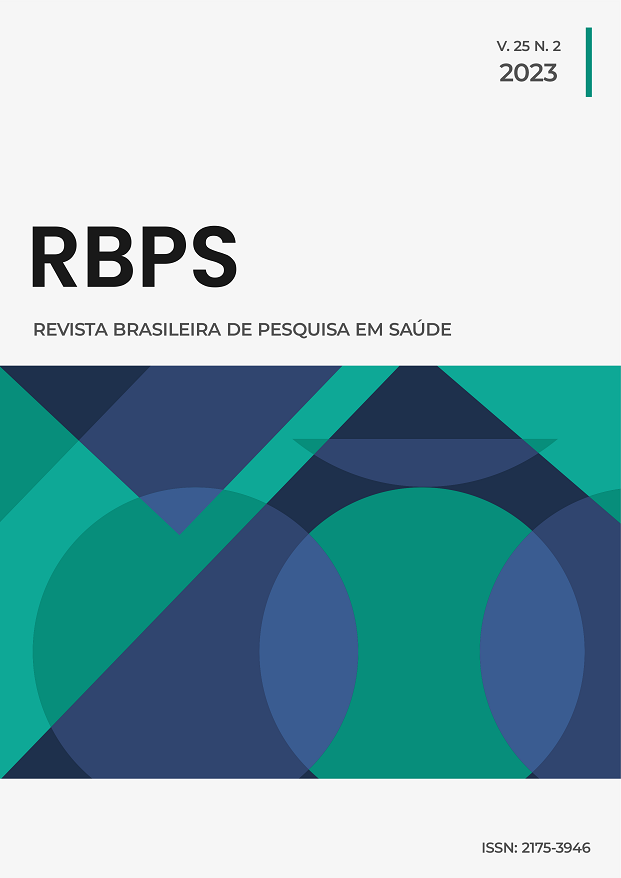Economic Impact of the Exposure to Residential Mold in the cases of Asthma in Brazil
DOI:
https://doi.org/10.47456/rbps.v25i2.37519Keywords:
Housing, Asthma, Fungi, MoldAbstract
Introduction: Asthma is one of the most common non-communicable diseases in the world. In Brazil, in 2019, it was responsible for approximately 79,900 hospitalizations in the public and complementary health systems alone. Residential mold is a recognized risk factor in the prevalence of asthma. Objectives: To analyze the attributable fraction to the exposure to housing mold and/or moisture in cases of asthma and its direct and indirect costs in Brazil. Methods: The prevalence of asthma and exposure to mold/humidity in Brazil was estimated over various time periods using data from multiple sources. Subsequently, the costs of hospitalizations in the Brazilian Unified Health System were analyzed. The fraction attributable to exposure to mold/humidity in asthma cases and costs in the country was calculated using the Bayes’ Theorem. Results: Research data reveal that the direct costs with asthma attributable to the exposure to residential mold and/or moisture in 2019 were BRL 54.8 million and, if added to the indirect costs, BRL 109.9 million, considering only data from public and complementary networks of the Brazilian health system. It was also possible to analyze that 2.4 million cases of asthma in Brazil can be attributed to exposure to housing mold and/or moisture. Conclusion: Providing adequate housing without the exposure factor for vulnerable populations has the potential to reduce direct and indirect costs in the health system and, in addition, provide an improvement in the quality of life of approximately 2.4 million asthmatic patients in the country.
Downloads
References
Bouillon CP, editor. Room for development: housing markets in Latin America and the Caribbean. London: Springer; 2012.
Cai J, Li B, Yu W, Wang H, Du C, Zhang Y et al. Household dampness-related exposures in relation to childhood asthma and rhinitis in China: A multicentre observational study. Envi¬ronment International. 2019;126:735-46.
Sandel M, Desmond M. Investing in Housing for Health Improves Both Mission and Margin. JAMA. 2017;318:2291-2.
Wang J, Zhao Z, Zhang Y, Li B, Huang C, Zhang X et al. Asthma, allergic rhinitis and eczema among parents of preschool chil¬dren in relation to climate, and dampness and mold in dwellings in China. Environment International. 2019;130:104910.
Ahlroth Pind C, Gunnbjörnsdottír M, Bjerg A, Järvholm B, Lundbäck B, Malinovschi A et al. Patient-reported signs of dampness at home may be a risk factor for chronic rhinosinus¬itis: a cross-sectional study. Clinical & Experimental Allergy. 2017;47:1383-9.
World Health Organization (WHO). WHO guidelines for indoor air quality: dampness and mold. Geneva: WHO; 2009.
Nascimento EC. Revisão sistemática e metanálise sobre asso¬ciação entre exposição ao mofo e umidade na habitação e asma: estimativa do impacto econômico para a sociedade brasileira. [dissertação]. Varginha: Universidade Federal de Alfenas; 2020.
Barreto BA, Sole D. Prevalence of asthma and associated factors in adolescents living in Belem (Amazon region). Allergology and immunopathology, Para, Brazil. 2014;42:427-32.
Kuschnir FC, Gurgel RQ, Solé D, Costa E, Felix MM, De Oliveira CL et al. ERICA: prevalência de asma em adolescentes brasile¬iros. Revista de Saúde Pública. 2016;50:13s-13s.
Prestes EX, Rozov T, Silva EM, Kopelman IB. Prevalência de asma em escolares de 13 e 14 anos na cidade de Belém-Pará, Bra¬sil. Revista Paulista de Pediatria. 2004;22:131-5.
To T, Stanojevic S, Moores G, Gershon AS, Bateman ED, Cruz AA et al. Global asthma prevalence in adults: findings from the cross-sectional world health survey. BMC Public Health. 2012;12:204.
Menezes AM, Wehrmeister FC, Horta B, Szwarcwald CL, Vieira ML, Malta DC. Prevalência de diagnóstico médico de asma em adultos brasileiros: Pesquisa Nacional de Saúde, 2013. Revista Brasileira de Epidemiologia. 2015;18:204-13.
ISAAC – The International Study of Asthma and Allergies in Childhood. ISAAC Phase Three Data. [cited 2021 Nov 20]. Available from: http://isaac.auckland.ac.nz/phases/phasethree/ results/results.php
IBGE – Instituto Brasileiro de Geografia e Estatística. Pesquisa Nacional em Saúde do Escolar (PeNSE): Tabelas 2012 – 2.14 Asma. [Internet]. IBGE; 2012. [cited 2021 Nov 10]. Available from: https:// www.ibge.gov.br/estatisticas/sociais/educacao/9134-pesquisa-na-cional-de-saude-do-escolar.html?edicao=17047&t=resultados
OMS – Organização Mundial da Saúde. World health survey (WHS) 2003 – Report of Brasil. [Internet]. OMS; 2003. [cited 2021 Nov 12]. Available from: https://www.who.int/healthinfo/ survey/whsbra-brazil.pdf
FIOCRUZ – Fundação Oswaldo Cruz. Painel de Indicadores de Saúde – Pesquisa Nacional de Saúde – 2019 – Módulo Q – Doenças Crônicas. Fiocruz; 2019. [cited 2021 Nov 17]. Avail¬able from: https://www.pns.icict.fiocruz.br/painel-de-indica¬dores-mobile-desktop/
IBGE – Instituto Brasileiro de Geografia e Estatística. Conheça o Brasil: população: pirâmide etária. [Internet]. IBGE; 2019. [cited 2021 Nov 11]. Available from: https://educa.ibge.gov.br/jovens/ conheca-o-brasil/populacao/18318-piramide-etaria.html
Brasil. Ministério da Saúde. Departamento de Informática do SUS (DataSUS). Morbidade hospitalar do SUS: por local de internação: Brasil. [Internet]. Brasília: Ministério da Saúde; 2016. [cited 2023 Oct 3]. Available from: http://tabnet.datasus.gov.br/ cgi/tabcgi.exe?sih/cnv/niuf.def
Haahtela T, Herse F, Karjalainen J, Klaukka T, Linna M, Leskelä et al. The Finnish experience to save asthma costs by improving care in 1987-2013. Journal of Allergy and Clinical Immunology. 2017;139(2):408-14.
Nurmagambetov T, Kuwahara R, Garbe P. The Economic Bur¬den of Asthma in the United States, 2008–2013. Annals of the American Thoracic Society. 2018;15(3):348-56.
Accordini S, Corsico AG, Braggion M, Gerbase MW, Gislason D, Gulsvik A et al. The cost of persistent asthma in Europe: an international population-based study in adults. International Archives of Allergy and Immunology. 2013;160(1):93-101.
Rappaport H; Bonthapally V. The Direct Expenditures and Indirect Costs Associated with Treating Asthma in the United States. Journal of Allergy and Therapy. 2012;3(2).
Rank MA, Liesinger JT, Ziegenfuss JY, Branda ME, Lim KG, Yawn BP et al. Asthma Expenditures in the United States Com¬paring 2004 to 2006 and 1996 to 1998. The American Journal Of Managed Care. 2012;18(9).
Cisternas MG, Blanc PD, Yen IH, Katz PP, Earnest G, Eisner MD et al. A comprehensive study of the direct and indirect costs of adult asthma. Journal of Allergy of Clinical Immunology. 2003;111(6):1212-8.
Levin ML. The occurrence of lung cancer in man. Acta Unio Internationalis Contra Cancrum. 1953;9:531-41.
Benichou, J. A review of adjusted estimators of attributable risk. Stat Methods Med Res. 2001;10(3):195-216.
Bahia LR, Rosa MQ; Araújo DV, Correia MG, Rosa RS, Duncan BB, Toscano CM. Economic burden of diabetes in Brazil in 2014. Diabetology & Metabolic Syndrome. 2019;11:54.
Mudarri DH, Fisk WJ. Public health and economic impact of dampness and mold. Indoor Air. 2007;17:226-35.
Simons E, To T, Dell S. The population attributable fraction of asthma among Canadian children. Can J Public Health. 2011;102(1):35-41.
Shoukri M, Donner A, Al-Mohanna F. Estimation of Attributable Risk from Clustered Binary Data: The Case of Cross-Sectional and Cohort Studies. Open Journal of Statistics. 2017;7(2):240-53.
Downloads
Published
How to Cite
Issue
Section
License
Copyright (c) 2023 Brazilian Journal of Health Research

This work is licensed under a Creative Commons Attribution-NonCommercial-NoDerivatives 4.0 International License.
Authors and reviewers must disclose any financial, professional, or personal conflicts of interest that could influence the results or interpretations of the work. This information will be treated confidentially and disclosed only as necessary to ensure transparency and impartiality in the publication process.
Copyright
RBPS adheres to the CC-BY-NC 4.0 license, meaning authors retain copyright of their work submitted to the journal.
- Originality Declaration: Authors must declare that their submission is original, has not been previously published, and is not under review elsewhere.
- Publication Rights: Upon submission, authors grant RBPS the exclusive right of first publication, subject to peer review.
- Additional Agreements: Authors may enter into non-exclusive agreements for the distribution of the RBPS-published version (e.g., in institutional repositories or as book chapters), provided the original authorship and publication by RBPS are acknowledged.
Authors are encouraged to share their work online (e.g., institutional repositories or personal websites) after initial publication in RBPS, with appropriate citation of authorship and original publication.
Under the CC-BY-NC 4.0 license, readers have the rights to:
- Share: Copy and redistribute the material in any medium or format.
- Adapt: Remix, transform, and build upon the material.
These rights cannot be revoked, provided the following terms are met:
- Attribution: Proper credit must be given, a link to the license provided, and any changes clearly indicated.
- Non-Commercial: The material cannot be used for commercial purposes.
- No Additional Restrictions: No legal or technological measures may be applied to restrict others from doing anything the license permits.

























